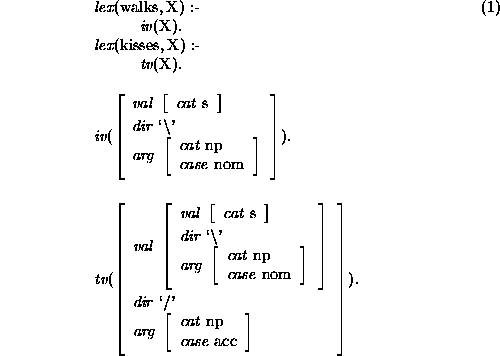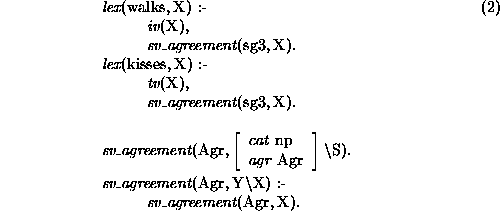


Next: Adjuncts as arguments Up: Recursive Constraints Previous: Recursive Constraints
Subject-verb agreement
Consider a categorial treatment of subject-verb agreement with
intransitive  and transitive
and transitive
 verbs defined as follows:
verbs defined as follows:

Subject-verb agreement can be incorporated easily if one reduces agreement to a
form of subcategorization. If, however, one wishes to distinguish these two
pieces of information (to avoid a proliferation of subcategorization types or
for morphological reasons, for instance), it is not obvious how this could be
done without recursive constraints. For intransitive verbs one needs the
constraint that  arg agr
arg agr = Agr (where Agr is
some agreement value), for transitive verbs that
= Agr (where Agr is
some agreement value), for transitive verbs that  val arg
agr
val arg
agr = Agr, and for ditransitive verbs that
= Agr, and for ditransitive verbs that  val val
arg agr
val val
arg agr = Agr. The generalization is captured using the
recursive constraint sv_agreement (2). In (2) and
below, we use definite clauses to define lexical entries and constraints. Note
that lexical entries relate words to feature structures that are defined
indirectly as a combination of simple constraints (evaluated by means of
unification) and recursive constraints.
= Agr. The generalization is captured using the
recursive constraint sv_agreement (2). In (2) and
below, we use definite clauses to define lexical entries and constraints. Note
that lexical entries relate words to feature structures that are defined
indirectly as a combination of simple constraints (evaluated by means of
unification) and recursive constraints.
Relational constraints can also be used to capture the effect of lexical rules.
In a lexicalist theory such as CG, in which syntactic rules are considered
to be universally valid scheme's of functor-argument combination, lexical rules
are an essential tool for capturing language-specific generalizations. As
Carpenter [3] observes, some of the rules that have
been proposed must be able to operate recursively. Predicative formation in
English, for instance, uses a lexical rule turning a category reducible to VP into a category reducing to a VP-modifier
 .
As a VP-modifier is reducible to VP, the rule can (and sometimes
must) be applied recursively.
.
As a VP-modifier is reducible to VP, the rule can (and sometimes
must) be applied recursively.
Gertjan van Noord
Fri Nov 25 16:22:41 MET 1994
